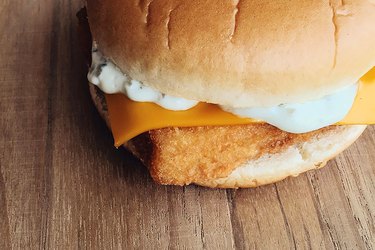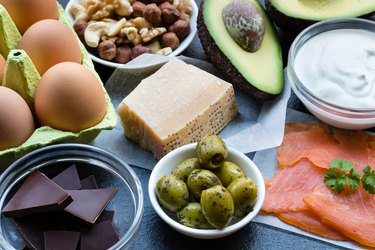
The McDonald's Filet-O-Fish has been a popular meat-free choice since 1965. This longtime menu staple is a convenient choice for pescatarians or anyone craving an alternative to a beef patty or chicken nuggets. But if this sandwich is your go-to order at McDonald's, you may be curious if the Filet-O-Fish is healthy.
To find out, we dug into the nutritional information and ingredients.
Video of the Day
Video of the Day
The Filet-O-Fish offers 16 grams of protein and has under 400 calories per serving. Do keep in mind though, that it does contain saturated fat, and is low in fiber, which helps keep you full.
Is Filet-O-Fish Healthy?
A quick look at the nutrition label for the sandwich reveals that it has 380 calories. Here are more of the key nutrition facts for the Filet-O-Fish:
- Calories: 380 calories
- Protein: 16 grams
- Total fat: 19 grams
- Carbohydrates: 38 grams
A general guideline is to aim for 15 to 30 grams of protein at each meal, per the Mayo Clinic; this sandwich hits that mark. The Filet-O-Fish also has about one-fourth of the fat you should eat in a day — not bad if you're having this as a meal — but keep in mind that it contains 4 grams of saturated fat, or 19 percent of your daily value (DV). Saturated fats, which are solid at room temperature, should be limited to only 6 percent of your daily caloric intake, per the American Heart Association. That is, if you typically aim for 2,000 calories a day, you should have around 13 grams of saturated fat; this sandwich contains about one-third of that amount.
The sandwich offers small amounts of calcium (4 percent of your daily value) and potassium (6 percent of your daily value). Worth noting: One sandwich contains 580 grams of sodium, or 25 percent of the sodium you should consume in a day.
It can be helpful to compare the Filet-O-Fish to another popular McDonald's menu item: The Big Mac. The Big Mac has more calories (580) as well as more protein (25 grams) and also has more fat (34 grams), which includes both saturated fat (11 grams) and trans fat (1 gram).

What Are the Ingredients for a Filet-O-Fish?
There are four main components to this sandwich:
Fish Patty
The fish in the patty is pollock, which is sometimes a sustainable choice, and sometimes isn't, depending on where it's caught, according to the Monterey Bay Aquarium Seafood Watch program. "McDonald's has sourced this fish back to where the fisheries are. They really did take the initiative to seek out responsible fisheries as part of the Sustainable Fisheries Act," says nutritionist Jennifer O'Donnell-Giles, RD
Other ingredients in the fish patty include water, flour and vegetable oil, as well as more surprising items like turmeric, which provides the patty's color.
Bun
One ingredient found in both the patty and bun is modified food starch. To ensure a super-crisp crust that locks in the moisture and fish flavor, the chain "puts a formulation around the fish that consists of flour, starch and some modifiers like cellulose gum and dextrose," says Paul Takhistov, PhD, associate professor of food engineering at the Department of Food Science at Rutgers University.
"When you put the fish in the oil, the crust should solidify almost immediately, otherwise the oil will be absorbed by the fish itself."
Tartar Sauce
A classic tartar sauce recipe combines mayonnaise with pickles and some herbs. The McDonald's version of tartar sauce has a larger list of ingredients, since it needs to remain shelf-stable. Sugar is a typical ingredient in tartar sauce, but O'Donnell-Giles points out that it's also found in the fish filet and bread. All in all, the sandwich contains 4 grams of sugar — according to the American Heart Association (AHA), people should have 25 to 36 grams of sugar per day at most.
Cheese
This sandwich also includes a slice of American cheese.
More on the Ingredient List
These four components include many ingredients, some that are easily recognized, such as "milk" or "enriched flours" and others that feel less familiar, like "Potassium Sorbate." While there are a number of other tough-to-pronounce ingredients on the label, they're actually pretty common, per our experts.
Here is a breakdown of the few top tongue twisters:
- Xanthan gum: Used in the tartar sauce, this thickener is commonly used in yogurt and pudding because it forms a gel structure with milk proteins, explains Takhistov, to create a creamy mouthfeel.
- Cellulose gum: Made from wood pulp, this additive in the fish patty is another thickener that helps give the crust its crunchiness.
- Potassium sorbate: This "stabilizer" in the tartar sauce prevents the separation of oil and water-based ingredients, explains Takhistov.
- Soy lecithin: An additive in the cheese, this helps oil and water mix to give food products a uniform appearance.
Bottom Line
Our experts had a lot to say about the nutritional makeup of this sandwich. It has 380 calories, which isn't a lot for a meal. But: "For a teeny sandwich, that's a lot of calories. My guess is that most people usually have two," says O'Donnell-Giles. That bumps you up to 760 calories. Adults should aim for 1,200 to 3,000 calories per day, per the Cleveland Clinic.
Depending on your size, the sandwich may have half of the fat you need in a day, O'Donnell-Giles says. And, as noted, some of the fat is saturated fat, which should be limited.
The Filet-O-Fish only has 1 gram of fiber, which helps stabilize blood sugar and keeps you feeling more full. "That's really low. I recommend having a salad with this to boost your fiber intake," says Giles.
Takhistov and O'Donnell-Giles agree that, at around 16 grams per serving, the Filet-O-Fish is a very good source of protein. Most of that protein comes from the fish — Atlantic pollock, which O'Donnell-Giles says does have some heart-healthy omega-3 fatty acids.
Takhistov adds that the sandwich doesn't contain suspicious ingredients that wouldn't be approved by the FDA. "I can't see any potential issue that would make it different from any fried product, like chicken nuggets," he says.
All that said: The Filet-O-Fish is best kept as an occasional order, not a daily meal. "If you eat this product three times per day and don't diversify your diet, of course this isn't healthy," says Takhistov. That means if it's your go-to fast food, go ahead and enjoy it a few times a month.
- McDonald's: "Filet-O-Fish®"
- Mayo Clinic: "Are You Getting Enough Protein?"
- American Heart Association: "Saturated Fat"
- McDonald's: "Big Mac®"
- Monterey Bay Aquarium Seafood Watch: "Sustainable pollock guide"
- American Heart Association: "How Much Sugar Is Too Much?"
- Cleveland Clinic: "How Many Calories Should You Eat in a Day?"


